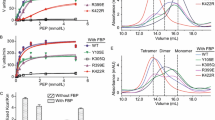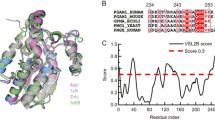Abstract
Tyrosine phosphorylation (p-Y105) of pyruvate kinase (PK) M2, in recent years, has been suggested to facilitate Warburg effect and tumor cell growth. However, a comparison of the structural dynamics of the un-phosphorylated, the active, and the phosphorylated-at-Y105, the inactive-states, is not clear. We studied molecular dynamics of the two states to unravel these features, where phosphorylated PKM2 showed a rapid global conformation change in the initial stages of the simulation. The overall simulation identified that the phosphorylation event results in more buried and less flexible PKM2 conformation, as compared to the un-phosphorylated form, resulting in an open and closed conformation of the active site in un-phosphorylated and phosphorylated forms, respectively, due to the movement of B domain. This conformational shift in Y105-phosphorylated-PKM2 (p-Y105-PKM2) with closed active site, responsible for inhibition of PKM2 activity, was an outcome of the bending residues (117–118, 218–219, 296–297, and 301–308) within the loop connecting A and B domains and the presence of helix-loop-helix motif in A domain. The un-phosphorylated PKM2 formed a helix bend (H4) due to less fluctuation of the residue S-100; where the other end of the helix (H4) was connected to the substrate binding pocket. Further, simulation analysis showed that phosphorylation did not affect the FBP binding predominantly. We propose that p-Y105 inhibits the activity of PKM2 without influencing FBP binding directly and not allowing the open binding conformation by influencing G128, S100, G506 and gamma turn, G126 and S127 residues. Phosphorylated PKM2 was also identified to gain the transcriptional factor function which was not the case with un-phosphorylated form. These structurally important residues in PKM2 could have a bearing on cancer metabolism, since PKM2 has been implicated in the promotion of cancer in the recent past.











Similar content being viewed by others
References
Mazurek S, Grimm H, Boschek CB, Vaupel P, Eigenbrodt E (2002) Pyruvate kinase type M2: a crossroad in the tumor metabolome. Br J Nutr 87(Suppl 1):S23–29
Kumar Y, Tapuria N, Kirmani N, Davidson BR (2007) Tumour M2-pyruvate kinase: a gastrointestinal cancer marker. Eur J Gastroenterol Hepatol 19(3):265–276. doi:10.1097/MEG.0b013e3280102f78
Yamada K, Noguchi T, Matsuda T, Takenaka M, Monaci P, Nicosia A, Tanaka T (1990) Identification and characterization of hepatocyte-specific regulatory regions of the rat pyruvate kinase L gene. The synergistic effect of multiple elements. J Biol Chem 265(32):19885–19891
Dombrauckas JD, Santarsiero BD, Mesecar AD (2005) Structural basis for tumor pyruvate kinase M2 allosteric regulation and catalysis. Biochem 44(27):9417–9429. doi:10.1021/bi0474923
Anastasiou D, Poulogiannis G, Asara JM, Boxer MB, Jiang JK, Shen M, Bellinger G, Sasaki AT, Locasale JW, Auld DS, Thomas CJ, Vander Heiden MG, Cantley LC (2011) Inhibition of pyruvate kinase M2 by reactive oxygen species contributes to cellular antioxidant responses. Sci 334(6060):1278–1283. doi:10.1126/science.1211485
Gupta V, Kalaiarasan P, Faheem M, Singh N, Iqbal MA, Bamezai RN (2010) Dominant negative mutations affect oligomerization of human pyruvate kinase M2 isozyme and promote cellular growth and polyploidy. J Biol Chem 285(22):16864–16873. doi:10.1074/jbc.M109.065029
Harris I, McCracken S, Mak TW (2012) PKM2: a gatekeeper between growth and survival. Cell Res 22(3):447–449. doi:10.1038/cr.2011.203
Christofk HR, Vander Heiden MG, Harris MH, Ramanathan A, Gerszten RE, Wei R, Fleming MD, Schreiber SL, Cantley LC (2008) The M2 splice isoform of pyruvate kinase is important for cancer metabolism and tumour growth. Nature 452(7184):230–233. doi:10.1038/nature06734
Schneider J, Neu K, Grimm H, Velcovsky HG, Weisse G, Eigenbrodt E (2002) Tumor M2-pyruvate kinase in lung cancer patients: immunohistochemical detection and disease monitoring. Anticancer Res 22(1A):311–318
Zhang B, Chen JY, Chen DD, Wang GB, Shen P (2004) Tumor type M2 pyruvate kinase expression in gastric cancer, colorectal cancer and controls. World J Gastroenterol 10(11):1643–1646
Hulleman E, Broekhuis MJ, Pieters R, Den Boer ML (2009) Pyruvate kinase M2 and prednisolone resistance in acute lymphoblastic leukemia. Haematologica 94(9):1322–1324. doi:10.3324/haematol.2009.011437
Luo W, Hu H, Chang R, Zhong J, Knabel M, O’Meally R, Cole RN, Pandey A, Semenza GL (2011) Pyruvate kinase M2 is a PHD3-stimulated coactivator for hypoxia-inducible factor 1. Cell 145(5):732–744. doi:10.1016/j.cell.2011.03.054
Yu H, Kortylewski M, Pardoll D (2007) Crosstalk between cancer and immune cells: role of STAT3 in the tumour microenvironment. Nat Rev Immunol 7(1):41–51. doi:10.1038/nri1995
Hitosugi T, Kang S, Vander Heiden MG, Chung TW, Elf S, Lythgoe K, Dong S, Lonial S, Wang X, Chen GZ, Xie J, Gu TL, Polakiewicz RD, Roesel JL, Boggon TJ, Khuri FR, Gilliland DG, Cantley LC, Kaufman J, Chen J (2009) Tyrosine phosphorylation inhibits PKM2 to promote the warburg effect and tumor growth. Sci Signal 2(97):ra73. doi:10.1126/scisignal.2000431
Van Der Spoel D, Lindahl E, Hess B, Groenhof G, Mark AE, Berendsen HJ (2005) GROMACS: fast, flexible, and free. J Comput Chem 26(16):1701–1718. doi:10.1002/jcc.20291
Scott WRP, Hünenberger PH, Tironi IG, Mark AE, Billeter SR, Fennen J, Torda AE, Huber T, Krüger P, van Gunsteren WF (1999) The GROMOS biomolecular simulation program package. J Phys Chem A 103(19):3596–3607. doi:10.1021/jp984217f
Berendsen HJC, Postma JPM, van Gunsteren WF, Hermans J (1981) Interaction models for water in relation to protein hydration. Intermolecular Forces 14:331–342. doi:citeulike-article-id:2139448
Schuttelkopf AW, van Aalten DM (2004) PRODRG: a tool for high-throughput crystallography of protein-ligand complexes. Acta Crystallogr Sect D: Biol Crystallogr 60(Pt 8):1355–1363. doi:10.1107/S0907444904011679
Berendsen HJC, Postma JPM, van Gunsteren WF, DiNola A, Haak JR (1984) Molecular dynamics with coupling to an external bath. J Chem Phys 81(8):3684–3690. doi:10.1063/1.448118
Parrinello M, Rahman A (1981) Polymorphic transitions in single crystals: a new molecular dynamics method. J Appl Phys 52(12):7182–7190. doi:10.1063/1.328693
Darden T, York D, Pedersen L (1993) Particle mesh Ewald: an N⋅log(N) method for Ewald sums in large systems. J Chem Phys 98(12):10089–10092. doi:10.1063/1.464397
Hess B, Bekker H, Berendsen HJC, Fraaije JGEM (1997) LINCS: a linear constraint solver for molecular simulations. J Comput Chem 18(12):1463–1472. doi:10.1002/(SICI)1096-987X(199709)18:12<1463::AID-JCC4>3.0.CO;2-H
Hayward S, Berendsen HJ (1998) Systematic analysis of domain motions in proteins from conformational change: new results on citrate synthase and T4 lysozyme. Proteins 30(2):144–154
Gupta V, Bamezai RN (2010) Human pyruvate kinase M2: a multifunctional protein. Protein Sci: Publ Protein Soc 19(11):2031–2044. doi:10.1002/pro.505
Israelsen WJ, Dayton TL, Davidson SM, Fiske BP, Hosios AM, Bellinger G, Li J, Yu Y, Sasaki M, Horner JW, Burga LN, Xie J, Jurczak MJ, DePinho RA, Clish CB, Jacks T, Kibbey RG, Wulf GM, Di Vizio D, Mills GB, Cantley LC, Vander Heiden MG (2013) PKM2 isoform-specific deletion reveals a differential requirement for pyruvate kinase in tumor cells. Cell 155(2):397–409. doi:10.1016/j.cell.2013.09.025
Marsh JA (2013) Buried and accessible surface area control intrinsic protein flexibility. J Mol Biol 425(17):3250–3263. doi:10.1016/j.jmb.2013.06.019
Acknowledgments
P.K. thanks Jammu and Kashmir Department of Science and Technology for Senior Research Fellowship in a supported project.
Author information
Authors and Affiliations
Corresponding author
Electronic supplementary material
Below is the link to the electronic supplementary material.
Supplementary Fig. 1
(DOC 432 kb)
Supplementary Fig. 2
(DOC 135 kb)
Supplementary Fig. 3
(DOC 267 kb)
Supplementary Fig. 4
(DOC 6517 kb)
Supplementary Fig. 5
(DOC 5266 kb)
Rights and permissions
About this article
Cite this article
Kalaiarasan, P., Subbarao, N. & Bamezai, R.N. Molecular simulation of Tyr105 phosphorylated pyruvate kinase M2 to understand its structure and dynamics. J Mol Model 20, 2447 (2014). https://doi.org/10.1007/s00894-014-2447-6
Received:
Accepted:
Published:
DOI: https://doi.org/10.1007/s00894-014-2447-6




